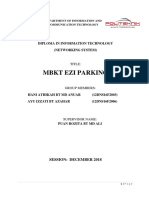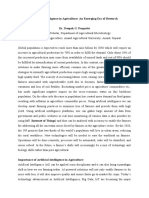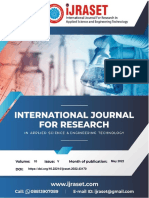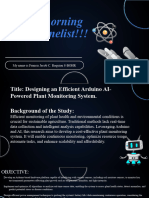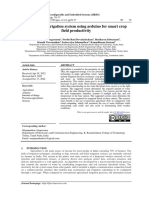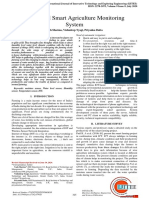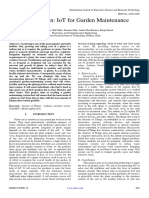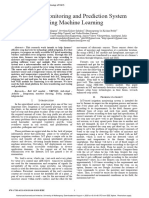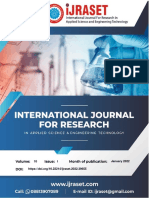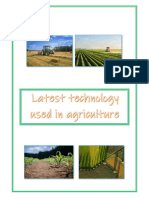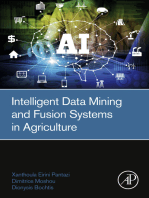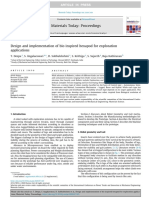Professional Documents
Culture Documents
Ragi Pest Control
Ragi Pest Control
Copyright
Available Formats
Share this document
Did you find this document useful?
Is this content inappropriate?
Report this DocumentCopyright:
Available Formats
Ragi Pest Control
Ragi Pest Control
Copyright:
Available Formats
Volume 9, Issue 4, April – 2024 International Journal of Innovative Science and Research Technology
ISSN No:-2456-2165 https://doi.org/10.38124/ijisrt/IJISRT24APR830
Ragi Pest Control
Sharanesh Prabhu Upase1 Nikhil2
Computer Science and Engineering Computer Science and Engineering
Dayananda Sagar University Bengaluru, India Dayananda Sagar University Bengaluru,India
Rakesh G S3 Chandru R4
Computer Science and Engineering Computer Science and Engineering
Dayanaanda Sagar University Bengaluru, India Dayananda Sagar University Bengaluru,India
Vedashree L V5 (Assistant Professor)
Computer Science and Engineering
Dayananda Sagar University Bengaluru,India
Abstract:- The rise of global population has put reduce the use of harmful chemicals in agriculture and
increasing pressure on the agriculture industry to meet improve crop yield while ensuring sustainable and
the demand for food. However, the growing use of environmentally friendly practices.
pesticides and insecticides in conventional farming
practices has caused significant harm to the environment Keywords:- Arduino, Programming, Pest Control.
and human health. Thus, there is a growing interest in
using sustainable agriculture practices that reduce the use I. INTRODUCTION
of these harmful chemicals. One such practice is pest
detection, which enables farmers to detect pests in their Agriculture is a vital industry that feeds the world's
crops before they cause significant damage. In this population. However, crop pests can cause significant damage
context, this project aims to develop a pest detection to crops, leading to lower yields and economic losses for
system using IoT and Arduino. The system will be farmers. Traditional pest monitoring methods involve manual
designed to detect pests in crops through a combination inspection of crops, which can be time-consuming and
of sensors and machine learning algorithms. The system inefficient. In recent years, there has been a growing interest
will consist of an Arduino microcontroller, soil moisture in using Internet of Things (IoT) technology to develop smart
sensors, temperature and humidity sensors, infrared agriculture systems that can automate the pest monitoring
sensors or camera modules, and a Wi-Fi or Bluetooth process. One such system is a pest detection system using IoT
module. The sensors will collect data on soil moisture and Arduino.
levels, temperature, humidity, and pest activity. The data
will be sent to a cloud-based server or database for The system uses sensors to monitor the environment in
analysis and visualization. The infrared sensor or camera which crops are growing, such as temperature, humidity, and
module will detect the presence of pests in the crops. The soil moisture. This data is sent to a cloud-based server or
system will use machine learning algorithms to database, where it is analysed and used to detect anomalies or
distinguish between pests and other objects, such as signs of pest damage. In addition, the system can use infrared
leaves or debris. When pests are detected, the system will sensors or camera modules to directly detect pests or pest
alert the farmer through a buzzer or LED connected to damage on the crops. Once pests are detected, the system
the Arduino board. The farmer can then take appropriate alerts the farmer through a buzzer or LED connected to the
action, such as applying pesticide or removing infested Arduino board.
plants. The pest detection system has the potential to
reduce the use of harmful pesticides and insecticides in This allows the farmer to take quick action to prevent
agriculture, as farmers will be able to identify pests further damage to the crops, such as applying pesticide or
before they cause significant damage. The system will also removing infested plants. The system cans also track and store
provide farmers with real-time information on pest pest detection data over time, providing valuable insights into
activity, enabling them to take proactive measures to pest trends and patterns.
control pests and reduce crop damage. Additionally, the
system can track and store the pest detection data over Overall, the pest detection system using IoT and
time, allowing farmers to monitor trends and patterns in Arduino offers a cost-effective and efficient solution to pest
pest activity. In conclusion, this project proposes the monitoring in agriculture. By automating the pest monitoring
development of a pest detection system using IoT and process, farmers can save time and money while protecting
Arduino that will enable farmers to monitor pest activity their crops from pests.
in their crops in real-time. The system has the potential to
IJISRT24APR830 www.ijisrt.com 1172
Volume 9, Issue 4, April – 2024 International Journal of Innovative Science and Research Technology
ISSN No:-2456-2165 https://doi.org/10.38124/ijisrt/IJISRT24APR830
A. Objectives B. Hardware Components
Early Detection of Pest Infestations: Soil Moisture Sensor Module Pinout Configuration
The system should be able to detect pests early on before
they can cause significant damage to crops, allowing farmers
to take proactive measures to control the pests and minimize
crop damage.
Real-Time Monitoring:
The system should provide real-time monitoring of crop
health and pest activity, allowing farmers to respond quickly
to any issues that arise.
Improved Accuracy:
The use of IoT sensors and data analysis can provide
more accurate and detailed information on crop health and
pest activity than traditional monitoring methods.
Cost-Effective:
The system should be cost-effective and easy to
implement, allowing farmers to adopt the technology without
significant financial investment. Fig 1 Soil Moisture Pinout
Environmentally Friendly: Arduino Board:
The system should minimize the use of harmful The most common board for IoT projects is the Arduino
pesticides and other chemicals, helping to reduce the Uno, but other boards like Arduino Mega or Node MCU can
environmental impact of agriculture. also be used.
Remote Access: Soil Moisture Sensor:
The system should allow farmers to remotely monitor This sensor is used to measure the moisture content of
their crops and receive alerts on their mobile devices or the soil around the plants. If the soil is too wet, it can lead to
computers, allowing them to take action even when they are root rot, and if it is too dry, it can cause the plant to wilt.
not on-site.
Soil Moisture Sensor Module Features & Specifications
Data Analysis:
The system should be able to collect and analyze data
over time, allowing farmers to identify trends and patterns in
pest activity and crop health. This can help them make more
informed decisions and optimize their farming practices.
A pest detection system using IoT and Arduino is an
automated system designed to detect the presence of pests in
crops and alert farmers to potential pest infestations. The
system uses IoT sensors to monitor environmental conditions
such as soil moisture, temperature, and humidity and sends
data to a cloud-based server or database. Additionally, an
infrared sensor or camera module is used to detect pests or
signs of pest damage in crops. If pests are detected, the
system alerts the farmer through a buzzer or LED connected
to the Arduino board.
Fig 2 Soil Moisture Specifications
This system is highly beneficial for farmers as it helps
to identify pests early, allowing for proactive measures to be Temperature and Humidity Sensor:
taken to control pest infestations and reduce crop damage. By This sensor measures the temperature and humidity
using IoT sensors and cloud-based data storage, the system levels in the environment. This information can be used to
can provide real-time data and enable farmers to monitor optimize plant growth and detect potential pest activity.
trends and patterns in pest activity. Overall, a pest detection
system using IoT and Arduino has the potential to improve
crop yields and reduce losses due to pest damage, ultimately
benefiting both farmers and consumers.
IJISRT24APR830 www.ijisrt.com 1173
Volume 9, Issue 4, April – 2024 International Journal of Innovative Science and Research Technology
ISSN No:-2456-2165 https://doi.org/10.38124/ijisrt/IJISRT24APR830
For DHT11 Sensor Power Source:
The system can be powered by a battery or an AC
adapter. The choice of power source will depend on the
location and environment of the system.
Other components such as resistors, capacitors, and
wires will also be needed to connect and integrate the various
components of the system.
C. Software Components
Ardunio IDE:
Fig 3 DHT11 Pinout This is the primary software used to program and upload
code to the Arduino board. It provides an integrated
DHT11 Specifications development environment for writing, compiling, and
uploading code to the board.
Sensor Libraries:
Depending on the specific sensor you are using in your
system, you may need to install and configure the necessary
sensor libraries to enable communication with the sensors. For
example, you may need to install the DHT sensor library for
the temperature and humidity sensor or the Adafruit Soil
Sensor library for the soil moisture sensor.
Wi-Fi Module Libraries:
Fig 4 DHT11 Specifications
If you are using a Wi-Fi or Bluetooth module to send
data to a cloud-based server, you will need to install and
Infrared Sensor or Camera Module: configure the necessary libraries for the module. For example,
This sensor detects the presence of pests in the area. An
you may need to install the ESP8266WiFi library for the
infrared sensor can detect the heat signature of pests, while a
ESP8266 Wi-Fi module.
camera module can take pictures of the plants to check for
signs of damage. Cloud-based Server or Database:
To store and analyze the data collected by the system,
Technical Details: you may need to set up a cloud-based server or database.
Popular options include AWS IoT, Azure IoT, and Google
Cloud IoT.
Programming Language:
You will need to write code in a programming language
such as C or C++ to communicate with the sensors and Wi-Fi
module, process the data, and send it to the cloud-based server
or database.
Data Visualization Tools:
To analyze and visualize the data collected by the
system, you may need to use tools such as Excel, Tableau, or
R. These tools can help identify trends and patterns in pest
activity over time.
Fig 5 TSL2561 Specifications
II. LITERATURE REVIEW
Wi-Fi or Bluetooth Module: Pest detection and control are critical components of
The module is used to connect the system to the internet modern agriculture. Pesticides have traditionally been used to
or a local network. It allows the system to send data to the control pests, but the overuse of pesticides can have negative
cloud for analysis and monitoring. environmental and health effects. As a result, there is a
growing interest in developing alternative pest control
Buzzer or LED: methods that are more sustainable and eco-friendly.
This Component is used to alert the farmer when pests
are detected. A buzzer can produce an audible alarm, while an
LED can flash to indicate the presence pests.
IJISRT24APR830 www.ijisrt.com 1174
Volume 9, Issue 4, April – 2024 International Journal of Innovative Science and Research Technology
ISSN No:-2456-2165 https://doi.org/10.38124/ijisrt/IJISRT24APR830
One such methods is the use of IoT and Arduino-based Implement the Hardware and Software Components:
pest detection systems. Several studies have been conducted Assemble the hardware components and write the
on the use of IoT and Arduino for pest detection in necessary software code to enable the sensors to collect data
agriculture. to the cloud, and trigger alerts when pests detected.
For example, in a study published in the Journal of Test the System:
Applied Science and Agriculture, researchers develop a Test the system to ensure that it is collecting accurate
wireless pest detection system that was able to detect pests data, transmitting data reliably, and detecting pests in a timely
such as thrips and aphids and send real-time alerts to farmers and effective manner.
via SMS.
Make any necessary adjustments to the hardware or
In another study published in the International Journal of software components to improve the performance of the
Agriculture and Biology, researchers developed a pest system.
detection system that used IoT sensors to detect the presence
of whiteflies in ragi crops. The system was able to accurately Deploy the System:
detect whitefly infestations with a detection rate of 92%. Deploy the pest detection system in the target
environment, ensuring that the hardware is properly installed,
The study also found that the use of the IoT-based and the software is functioning as expected.
system reduced the need for pesticides and increased crop
yield. Similarly, in a study published in the Journal of Monitor and Refine the System:
Electrical and Electronics Engineering, researchers developed Monitor the system over time to ensure that it continues
a smart pest detection system using IoT and machine learning to meet the project objectives and refine the system as
algorithms. The system was able to detect pests such as necessary based on new data or changing requirements.
mealybugs, thrips, and spider mites with a detection accuracy
of up to 95%. The study also found that the system was able Define the System
to reduce the use of pesticides by up to 50%. A pest Detection system using IoT and Arduino is a
system that uses sensors and microcontrollers to monitor
Overall, the literature suggests that IoT and Arduino- crops for the presence of pests and provide real – time alerts
based pest detection systems have the potential to to farmers. The system typically includes an Arduino board or
revolutionize pest control in agriculture. By providing real- similar microcontroller connected to various sensors, Such as
time data on pest infections, farmers can take proactive soil moisture sensors, temperature and humidity sensors,
measures to control pests and reduce the need for harmful infrared sensors or camera modules, and Wi-Fi or Bluetooth
pesticides. However, more research is needed to fully evaluate modules.
the effectiveness and scalability of these systems in a variety
of agricultural contexts. The sensors collect data on crop health and
environmental conditions and send it to a cloud-based server
III. METHODOLOGY or database for analysis. The system can also use infrared
sensors or camera modules to detect the presence of pests or
Define the Objectives: signs of the pest damage in the crops. If pests are detected, the
Determine the goals of the pest detection systems, system will alert the farmers through a buzzer or LED
including the specific pests to be monitored, the crops to be connected to the Arduino board. The farmer can then take
protected, and the desired level of accuracy and timeless in appropriate action, such as applying pesticide or removing
detecting pests. infected plants.
Select the Hardware and Software Components: The system can also store and analyze pest detection
Select the appropriate hardware and software data over time, allowing farmers to monitor trends and
components based on the project objectives, budget, and patterns in pest activity. By providing real-time data on crop
technical expertise. Common components may include an health and pest activity, a pest detection system using IoT and
Arduino microcontroller, sensors such as soil moisture, Arduino can help farmers optimize the growing conditions,
temperature and humidity, and infrared sensors, a Wi-Fi or reduce crop damage, and increase crop yields.
Bluetooth module for data transmission, and a cloud-based
server for data storage and analysis. Design the System
Design the System Architecture: Hardware Components:
Create a system architecture that details how the various
hardware and software components will work together to Arduino Uno or similar microcontroller
achieve the objectives of the pest detection system. This Soil moisture sensor
should include details on the data flow, sensor readings, and DHT11 temperature and humidity sensor
communication protocols. Infrared sensor or camera module
ESP8266 WiFi module
Buzzer or LED for alerting
IJISRT24APR830 www.ijisrt.com 1175
Volume 9, Issue 4, April – 2024 International Journal of Innovative Science and Research Technology
ISSN No:-2456-2165 https://doi.org/10.38124/ijisrt/IJISRT24APR830
9V battery or AC adapter Overall, the pest detection system using IoT and
Breadboard and jumper wires Arduino can help farmers monitor pest activity in their crops
and take action to control infestations before they cause
Software Components: significant damage.
Arduino IDE Flow Chart
Libraries for the soil moisture sensor, DHT11 sensor, and
ESP8266 Wi-Fi module
Step 1: Selecting up the Hardware
Connect the soil moisture sensor to the Arduino board's
analog input pins A0.
Connect the DHT11 temperature and humidity sensor to
the Arduino board’s digital pins 2.
Connect the infrared sensor or camera module to the
Arduino board’s digital pins 4.
Connect the ESP8266 Wi-Fi module to the Arduino
board’s digital pins 7 and 8.
Connect the buzzer and LED to the Arduino board’s
digital pins 10.
Connect the power source to the Arduino boar’s power
port.
Step 2: Installing the Necessary Libraries
Install the Adafruit DHT library for the DHT11 sensor.
Install the ESP8266 Wi-Fi library for the ESP8266
module.
Install the Adafruit_Sensor and Adafruit_TSL2561
libraries for the infrared sensor or camera module.
Step 3: Writing the Code
Start by defining the pins for the sensors and Wi-Fi
module in the Arduino code.
Use the ‘setup()’function to initialize the sensors and Wi-
Fi module.
Use the ‘loop()’ function to read the sensor data and send
it to a cloud-based server or database using the ESP8266
module. Use the infrared sensor or camera module to
detect the presence of pests or signs of pest damage in the
crops.
If pests are detected, the system should trigger the buzzer
or LED to alert the farmer.
The system can also track and store the pest detection data
over time, allowing farmers to monitor trends and patterns
in pest activity.
Step 4: Testing the System
Power up the Arduino board and verify that the sensors
and Wi-Fi module are functioning properly.
Place the infrared sensor or camera module near the crops
to detect the pests or signs of pest damage.
Observe the system’s behavior when pests are detected,
including the buzzer or LED alert and the data transmitted Fig 1 Flow Chart of the System
to the cloud-based server or database.
IJISRT24APR830 www.ijisrt.com 1176
Volume 9, Issue 4, April – 2024 International Journal of Innovative Science and Research Technology
ISSN No:-2456-2165 https://doi.org/10.38124/ijisrt/IJISRT24APR830
Algorithm Finally, the system requires a stable internet connection
to transmit data to the cloud-based server or database. In areas
int main() with poor internet connectivity, the system may not work as
{setup(); effectively.
While (true)
{ loop(); } Conclusion:
return 0;} In conclusion, the pest detection system using IoT and
void setup() { Arduino has the potential to help farmers detect pest
pinMode(IR_SENSOR_PIN, INPUT); infestations early and reduce crop damage. However, it's
pinMode(BUZZER_PIN, OUTPUT); important to use the system in conjunction with other pest
Serial.begin(115200); control methods and to be mindful of the environmental and
connectToWiFi();} health impacts of pesticides. Additionally, future iterations of
void loop() { the system should address the limitations discussed above.
int Irvalue = analogRead(IR_SENSOR_PIN);
if (Irvalue > THRESHOLD) { V. CONCLUSION
digitalWrite(BUZZER_PIN, HIGH);
sendToServer("Pests detected"); } else { In conclusion, a pest detection system using IoT and
digitalWrite(BUZZER_PIN, LOW);} Arduino can be an effective tool for farmers to monitor their
delay(1000);} crops for Signs of pest infestations and take appropriate
action. By using sensors to track environmental conditions
IV. RESULT AND DISCUSSION and detect the presence of pests or signs of pest damage,
farmers can quickly respond to potential problems and prevent
Introduction: crop losses.
Pest infestation is a major problem faced by farmers, and
it can lead to significant crop damage and loss. To address this Additionally, by storing and analyzing the pest detection
issue, we developed a pest detection system using IoT and data over time, farmers can gain insights into trends and
Arduino. The system uses sensors to monitor soil moisture, patterns in pest activity, allowing them to make informed
temperature, and humidity, and an infrared sensor to detect decisions about pest control strategies. overall, a pest
the presence of pests or signs of pest damage in the crops. In detection system using IoT and Arduino can help farmers
this section, we present the results and discuss the increase crop yield and improve the overall health of their
performance of the system. crops, leading to more sustainable and profitable agricultural
practices.
Results:
We tested the pest detection system on a small-scale REFERENCES
farm with a variety of crops, including tomatoes, cucumbers,
and peppers. The system successfully detected the presence of [1]. "Design of smart agricultural system based on Internet
pests such as aphids and spider mites, as well as signs of pest of Things" by Y. Zhang et al. in IOP Conference
damage such as wilting leaves and browning spots on the Series: Earth and Environmental Science (2018).
leaves. The system was able to provide real-time alerts to the [2]. "Design and Implementation of a Smart Irrigation
farmer through a buzzer and LED connected to the Arduino System Using Internet of Things (IoT) and Arduino"
board, allowing them to take immediate action to address the by M. A. Islam et al. in Journal of Sensors (2018).
pest infestation. The system also provided historical data on [3]. "Design and Development of a Smart Soil Monitoring
pest activity, allowing the farmer to monitor trends and System for Precision Agriculture" by S. O. Oyedeji et
patterns over time. al. in IEEE Access (2019).
[4]. "A Review of Smart Farming Technologies and their
Discussion: Applications" by R. Anand and P. Srivastava in SN
Overall, the pest detection system performed well in Computer Science (2020).
detecting pests and providing real-time alerts to the farmer. [5]. "Smart Pest Detection System for Agriculture Using
However, there are some limitations to the system that should Internet of Things" by J. P. Singh et al. in 2019 IEEE
be addressed in future iterations. First, the system relies on the International Conference on Smart Electronics and
use of pesticides to control pest infestations. While pesticides Communication (ICOSEC) (2019) .
can be effective in reducing pest damage, they can also have [6]. Sharma, S., & Kumar, V. (2018). Design and
negative environmental and health impacts. Therefore, it's Implementation of an IoT-based pest detection and
important to use pesticides judiciously and explore alternative control system. International Journal of Advanced
pest control methods. Research in Computer Science, 9(2), 118-121.
[7]. Kumar, P., Kumar, A., & Singh, R. (2017). A review
Second, the system only detects pests that are visible on on IoT based pest detection and control system.
the surface of the leaves, and it may not detect pests that are International Journal of Advanced Research in
hiding in the soil or in other parts of the plant. Therefore, it's Computer Engineering & Technology, 6(3), 64- 68.
important to use a variety of pest control methods and to
regularly inspect plants for signs of infestation.
IJISRT24APR830 www.ijisrt.com 1177
Volume 9, Issue 4, April – 2024 International Journal of Innovative Science and Research Technology
ISSN No:-2456-2165 https://doi.org/10.38124/ijisrt/IJISRT24APR830
[8]. Singh, A. K., & Patel, R. K. (2020). IoT-based smart
pest detection and control system for precision
agriculture. In Proceedings of the 4th International
Conference on Computing Methodologies and
Communication (pp. 1234- 1242). Springer.
[9]. Tandon, N., Khanna, P., & Bhalla, S. (2019). IoT
based pest detection and control system for smart
agriculture. In Proceedings of the 5th International
Conference on Inventive Computation Technologies
(pp. 587-592). IEEE.
[10]. Agrawal, R., Jha, S. K., & Mandal, J. K. (2019). Smart
pest detection system for precision agriculture using
IoT. In Proceedings of the 2nd International
Conference on Communication, Devices and
Computing (pp. 862-866). IEEE.
[11]. A Review of Smart Farming Technologies and their
Applications" by R. Anand and P. Srivastava in SN
Computer Science (2020).
[12]. Sri Sruthi, S.; Swarna, N.; Ros, G.M.S.; Elizabeth, E.
Sustainable agriculture using eco-friendly and energy
efficient sensor technology. In Proceedings of the 2016
IEEE: Bangalore, India, 2016.
[13]. Aslam, S.; Khalid, A.; Javaid, N. Towards Efficient
Energy Management in Smart Grids Considering
Microgrids with Day-ahead Energy Forecasting.
Electr. Power Syst. Res. 2020.
[14]. Sharma, R.P.; Ramesh, D.; Pal, P.; Tripathi, S.;
Kumar, C. IoT-enabled IEE 802.15 .4 WSN
monitoring infrastructure-driven fuzzy-logic-based
crop pest prediction. IEEE Internet Things J. 2021.
[15]. Smart Pest Detection System for Agriculture Using
Internet of Things" by J. P. Singh et al. in 2019 IEEE
International Conference on Smart Electronics and
Communication (ICOSEC) (2019).
[16]. These sources provide insights and ideas for designing
and implementing a pest control system using IoT and
Arduino in precision agriculture.
IJISRT24APR830 www.ijisrt.com 1178
You might also like
- IOT Based Smart Plant Monitoring SystemDocument8 pagesIOT Based Smart Plant Monitoring SystemIJRASETPublicationsNo ratings yet
- Serial Communication in Arduino UnoDocument3 pagesSerial Communication in Arduino UnoDeepak KumbharNo ratings yet
- Proposal Ezi ParkingDocument16 pagesProposal Ezi ParkingShima NaizNo ratings yet
- A Smart Farming and "Crop Monitoring Technology" in Agriculture Using IOTDocument11 pagesA Smart Farming and "Crop Monitoring Technology" in Agriculture Using IOTIJRASETPublicationsNo ratings yet
- Artificial IntelligencechapterDocument8 pagesArtificial IntelligencechapterTolĩnĩo Däba AmenũNo ratings yet
- Microcontroller Based Smart Crop ProtectionDocument3 pagesMicrocontroller Based Smart Crop ProtectionInternational Journal of Innovative Science and Research TechnologyNo ratings yet
- Smart Irrigation Technique Using IOTDocument6 pagesSmart Irrigation Technique Using IOTIJRASETPublicationsNo ratings yet
- Smart Irrigation System Using Automated RoverDocument4 pagesSmart Irrigation System Using Automated RoverInternational Journal of Innovative Science and Research TechnologyNo ratings yet
- IoT Based Smart Irrigation SystemDocument4 pagesIoT Based Smart Irrigation SystemEditor IJTSRD100% (2)
- Iot Based Agricultural Field Monitoring System Using Microcontroller With Remote AccessDocument49 pagesIot Based Agricultural Field Monitoring System Using Microcontroller With Remote AccessAbdul Razzak100% (1)
- Underground Cable Fault DetectionDocument17 pagesUnderground Cable Fault DetectionTanzil57% (7)
- Ece305 - PR2 - Project ProposalDocument8 pagesEce305 - PR2 - Project ProposalEDUARD VI DANDANo ratings yet
- A Smart Solution For Plant Disease Detection Based On Iot: November 2020Document4 pagesA Smart Solution For Plant Disease Detection Based On Iot: November 2020Mangala NageshwariNo ratings yet
- Design and Development of Pest Monitoring System For Implementing Precision Agriculture Using IOTDocument3 pagesDesign and Development of Pest Monitoring System For Implementing Precision Agriculture Using IOTIJSTENo ratings yet
- Ece305 - Project ProposalDocument7 pagesEce305 - Project ProposalEDUARD VI DANDANo ratings yet
- What Is Precision AgricultureDocument27 pagesWhat Is Precision AgricultureMartin OtienoNo ratings yet
- SynopsisDocument7 pagesSynopsistsuu0213No ratings yet
- Ijarcce 2019 8504Document4 pagesIjarcce 2019 8504Soham GhagNo ratings yet
- Paper 8566Document8 pagesPaper 8566IJARSCT JournalNo ratings yet
- Precision FarmingDocument4 pagesPrecision FarmingEditor IJTSRDNo ratings yet
- researchDocument15 pagesresearchSylphiette AddairNo ratings yet
- Humanoid Robot Pitch DeckDocument8 pagesHumanoid Robot Pitch Deckraquionfrancis231No ratings yet
- Smart Agriculture Monitoring System Using Iot: P. Prema, B. Sivasankari, M. Kalpana and R. VasanthiDocument6 pagesSmart Agriculture Monitoring System Using Iot: P. Prema, B. Sivasankari, M. Kalpana and R. Vasanthisri krishNo ratings yet
- Automation Irrigation System Using Arduino For Smart Crop Field ProductivityDocument8 pagesAutomation Irrigation System Using Arduino For Smart Crop Field ProductivityIJRES teamNo ratings yet
- Iot-Enabled Smart Agriculture System With Deep Learning For The Identification of Plant DiseaseDocument11 pagesIot-Enabled Smart Agriculture System With Deep Learning For The Identification of Plant DiseaseAJAY VISHAL R PNo ratings yet
- 5) Ijirt151824 PaperDocument6 pages5) Ijirt151824 PaperhexemapNo ratings yet
- Convergence 66 PDFDocument9 pagesConvergence 66 PDFPurnesh ReddyNo ratings yet
- Climate Change Adaptation in Agriculture: IoT-Enabled Weather MonitoringDocument5 pagesClimate Change Adaptation in Agriculture: IoT-Enabled Weather MonitoringInternational Journal of Innovative Science and Research TechnologyNo ratings yet
- Technical Paper On Environmental Monitor and Control, Pests and Diseases in The GreenhouseDocument7 pagesTechnical Paper On Environmental Monitor and Control, Pests and Diseases in The GreenhouseInternational Journal of Innovative Science and Research TechnologyNo ratings yet
- IOT Based Smart Agriculture Monitoring System: Yash Sharma, Vishudeep Tyagi, Priyanka DattaDocument4 pagesIOT Based Smart Agriculture Monitoring System: Yash Sharma, Vishudeep Tyagi, Priyanka DattaNitin ManneNo ratings yet
- IoT Based Smart Agriculture and Animal Detection SystemDocument12 pagesIoT Based Smart Agriculture and Animal Detection SystemIJRASETPublicationsNo ratings yet
- Irjet V7i6467Document5 pagesIrjet V7i6467Raghavendra KusoorNo ratings yet
- Smart Agriculture Using IotDocument7 pagesSmart Agriculture Using IotShanaya chauhanNo ratings yet
- Iot Based Smart Agricultural Monitoring SystemDocument7 pagesIot Based Smart Agricultural Monitoring SystemMuhammad AbubakerNo ratings yet
- Sambath 2019 J. Phys. Conf. Ser. 1362 012069Document7 pagesSambath 2019 J. Phys. Conf. Ser. 1362 012069Melrown BarrettoNo ratings yet
- IntelliGarden IoT For Garden MaintenanceDocument6 pagesIntelliGarden IoT For Garden MaintenanceInternational Journal of Innovative Science and Research TechnologyNo ratings yet
- Iot Based Smart Home Garden Watering SystemDocument5 pagesIot Based Smart Home Garden Watering SystemManasiNo ratings yet
- Smart Agriculture System Using InternetDocument4 pagesSmart Agriculture System Using Internetmukeshpriyas3No ratings yet
- 10 1109@incet49848 2020 9153993Document5 pages10 1109@incet49848 2020 9153993Cartório Terceiro Ofício de NotasNo ratings yet
- Crop 2021Document4 pagesCrop 2021mehetreshital1212No ratings yet
- Iarjset 2021 8741Document6 pagesIarjset 2021 8741ravi chanduNo ratings yet
- IOT Based Crop Monitoring SystemDocument8 pagesIOT Based Crop Monitoring SystemIJRASETPublicationsNo ratings yet
- Smart Agriculture System Using IoT BasedDocument6 pagesSmart Agriculture System Using IoT BasedIJRASETPublicationsNo ratings yet
- CropsIT - A Portable Soil Analysis and Crop Suggestion SystemDocument7 pagesCropsIT - A Portable Soil Analysis and Crop Suggestion SystemIJRASETPublicationsNo ratings yet
- 32 121 1 PBDocument10 pages32 121 1 PB22VLF02 ME VLSI DESIGNNo ratings yet
- Research Paper On Vegetation Health Monitoring Using Agricultural IOTDocument3 pagesResearch Paper On Vegetation Health Monitoring Using Agricultural IOTEditor IJRITCCNo ratings yet
- Ijet 17653Document4 pagesIjet 17653TaufiqurrahmanNo ratings yet
- Smart Agriculture System ProjectDocument105 pagesSmart Agriculture System Project202-GCET-19No ratings yet
- Extract File 20221012 010409Document5 pagesExtract File 20221012 010409Poornima NNo ratings yet
- An Efficient Indoor Nursery Controlled by IOT and Monitored by Android App.Document4 pagesAn Efficient Indoor Nursery Controlled by IOT and Monitored by Android App.International Journal of Innovative Science and Research TechnologyNo ratings yet
- Smart Leaf Disease Detection: P.Vamsicharan Reddy, G.Samarasimha Reddy, P.V.Sai Vaibhav, S.SundarDocument5 pagesSmart Leaf Disease Detection: P.Vamsicharan Reddy, G.Samarasimha Reddy, P.V.Sai Vaibhav, S.Sundarsinichi_kudoo21No ratings yet
- IRJET - V7I7479 With Cover Page v2Document4 pagesIRJET - V7I7479 With Cover Page v2AliNo ratings yet
- Mini ProjectDocument58 pagesMini ProjectHarish KhanNo ratings yet
- 11 VI June 2023Document5 pages11 VI June 2023kriza balNo ratings yet
- 1.1. Existing SystemDocument17 pages1.1. Existing SystemmujeebNo ratings yet
- Iot Based Irrigation Remote Real-Time Monitoring and Controlling SystemsDocument6 pagesIot Based Irrigation Remote Real-Time Monitoring and Controlling SystemsMuhammad AbubakerNo ratings yet
- Computer NewDocument4 pagesComputer Newsunita vermaNo ratings yet
- Early Detection of Onion Spoilage Utilizing IoT and AI during Storage and TransportationDocument6 pagesEarly Detection of Onion Spoilage Utilizing IoT and AI during Storage and TransportationInternational Journal of Innovative Science and Research TechnologyNo ratings yet
- Automation in Hydroponic Farming Eco-System: A Review: e-ISSN: 2456-3463Document4 pagesAutomation in Hydroponic Farming Eco-System: A Review: e-ISSN: 2456-3463bilal hassanNo ratings yet
- Smart Phone and Iot Based Tool For Integrated Farm MonitoringDocument9 pagesSmart Phone and Iot Based Tool For Integrated Farm Monitoringbhumi.m224No ratings yet
- IJCRT2403365Document6 pagesIJCRT2403365antisocialcommunityyNo ratings yet
- Internet of Things (IoT): IoT Security, Privacy and Applications in Various Industries/ Part 2From EverandInternet of Things (IoT): IoT Security, Privacy and Applications in Various Industries/ Part 2No ratings yet
- Intelligent Data Mining and Fusion Systems in AgricultureFrom EverandIntelligent Data Mining and Fusion Systems in AgricultureNo ratings yet
- Solar Based Multilevel Inverter f o r BLDC Motor DriveDocument8 pagesSolar Based Multilevel Inverter f o r BLDC Motor DriveInternational Journal of Innovative Science and Research TechnologyNo ratings yet
- Meta Land: Redefining Virtual Communities through Centralized Governance, Inclusivity and InnovationDocument5 pagesMeta Land: Redefining Virtual Communities through Centralized Governance, Inclusivity and InnovationInternational Journal of Innovative Science and Research TechnologyNo ratings yet
- Skin Disease Detection and Remedial SystemDocument7 pagesSkin Disease Detection and Remedial SystemInternational Journal of Innovative Science and Research TechnologyNo ratings yet
- Exploring the Potential Advantages of Traditional Therapies in Autoimmune Blistering Illnesses: A Comprehensive Review and Analysis, ResearchDocument12 pagesExploring the Potential Advantages of Traditional Therapies in Autoimmune Blistering Illnesses: A Comprehensive Review and Analysis, ResearchInternational Journal of Innovative Science and Research TechnologyNo ratings yet
- Development of Smart Ground Fault Location Model for Radial Distribution SystemDocument14 pagesDevelopment of Smart Ground Fault Location Model for Radial Distribution SystemInternational Journal of Innovative Science and Research TechnologyNo ratings yet
- EmoConnect: Nurturing Trust and Relationship Bonds in Alzheimer’s ConversationsDocument3 pagesEmoConnect: Nurturing Trust and Relationship Bonds in Alzheimer’s ConversationsInternational Journal of Innovative Science and Research TechnologyNo ratings yet
- Unlocking Sentiments: Enhancing IOCL Petrol Pump ExperiencesDocument8 pagesUnlocking Sentiments: Enhancing IOCL Petrol Pump ExperiencesInternational Journal of Innovative Science and Research TechnologyNo ratings yet
- Design and Development of Multi-Featured Medical StretcherDocument4 pagesDesign and Development of Multi-Featured Medical StretcherInternational Journal of Innovative Science and Research TechnologyNo ratings yet
- Seasonal Variation and Distribution Patterns of Endophytic Community in Withania somniferaDocument7 pagesSeasonal Variation and Distribution Patterns of Endophytic Community in Withania somniferaInternational Journal of Innovative Science and Research TechnologyNo ratings yet
- Preparation and Identification of Magnetic Iron Nanoparticle based on a Natural Hydrogel and its Performance in Targeted Drug DeliveryDocument17 pagesPreparation and Identification of Magnetic Iron Nanoparticle based on a Natural Hydrogel and its Performance in Targeted Drug DeliveryInternational Journal of Innovative Science and Research TechnologyNo ratings yet
- Smart and Secure Home with ChatbotDocument9 pagesSmart and Secure Home with ChatbotInternational Journal of Innovative Science and Research TechnologyNo ratings yet
- Exploring the Post-Annealing Influence on Stannous Oxide Thin Films via Chemical Bath Deposition Technique: Unveiling Structural, Optical, and Electrical DynamicsDocument7 pagesExploring the Post-Annealing Influence on Stannous Oxide Thin Films via Chemical Bath Deposition Technique: Unveiling Structural, Optical, and Electrical DynamicsInternational Journal of Innovative Science and Research TechnologyNo ratings yet
- Reading Intervention Through “Brigada Sa Pagbasa”: Viewpoint of Primary Grade TeachersDocument3 pagesReading Intervention Through “Brigada Sa Pagbasa”: Viewpoint of Primary Grade TeachersInternational Journal of Innovative Science and Research TechnologyNo ratings yet
- Application of Game Theory in Solving Urban Water Challenges in Ibadan-North Local Government Area, Oyo State, NigeriaDocument9 pagesApplication of Game Theory in Solving Urban Water Challenges in Ibadan-North Local Government Area, Oyo State, NigeriaInternational Journal of Innovative Science and Research TechnologyNo ratings yet
- On the Development of a Threat Driven Model for Campus NetworkDocument14 pagesOn the Development of a Threat Driven Model for Campus NetworkInternational Journal of Innovative Science and Research TechnologyNo ratings yet
- Firm Size as a Mediator between Inventory Management Andperformance of Nigerian CompaniesDocument8 pagesFirm Size as a Mediator between Inventory Management Andperformance of Nigerian CompaniesInternational Journal of Innovative Science and Research TechnologyNo ratings yet
- Global Warming Reduction Proposal AssessmentDocument6 pagesGlobal Warming Reduction Proposal AssessmentInternational Journal of Innovative Science and Research TechnologyNo ratings yet
- Application of Plant Growth Promoting Rhizobacteria on Vegetative Growth in Chili Plants (Capsicum frutescens L.)Document7 pagesApplication of Plant Growth Promoting Rhizobacteria on Vegetative Growth in Chili Plants (Capsicum frutescens L.)International Journal of Innovative Science and Research TechnologyNo ratings yet
- A Study to Assess the Knowledge Regarding Teratogens Among the Husbands of Antenatal Mother Visiting Obstetrics and Gynecology OPD of Sharda Hospital, Greater Noida, UpDocument5 pagesA Study to Assess the Knowledge Regarding Teratogens Among the Husbands of Antenatal Mother Visiting Obstetrics and Gynecology OPD of Sharda Hospital, Greater Noida, UpInternational Journal of Innovative Science and Research TechnologyNo ratings yet
- PHREEQ C Modelling Tool Application to Determine the Effect of Anions on Speciation of Selected Metals in Water Systems within Kajiado North Constituency in KenyaDocument71 pagesPHREEQ C Modelling Tool Application to Determine the Effect of Anions on Speciation of Selected Metals in Water Systems within Kajiado North Constituency in KenyaInternational Journal of Innovative Science and Research TechnologyNo ratings yet
- The Impact of Music on Orchid plants Growth in Polyhouse EnvironmentsDocument5 pagesThe Impact of Music on Orchid plants Growth in Polyhouse EnvironmentsInternational Journal of Innovative Science and Research Technology100% (1)
- Mandibular Mass Revealing Vesicular Thyroid Carcinoma A Case ReportDocument5 pagesMandibular Mass Revealing Vesicular Thyroid Carcinoma A Case ReportInternational Journal of Innovative Science and Research TechnologyNo ratings yet
- Detection of Phishing WebsitesDocument6 pagesDetection of Phishing WebsitesInternational Journal of Innovative Science and Research TechnologyNo ratings yet
- Consistent Robust Analytical Approach for Outlier Detection in Multivariate Data using Isolation Forest and Local Outlier FactorDocument5 pagesConsistent Robust Analytical Approach for Outlier Detection in Multivariate Data using Isolation Forest and Local Outlier FactorInternational Journal of Innovative Science and Research TechnologyNo ratings yet
- Esophageal Melanoma - A Rare NeoplasmDocument3 pagesEsophageal Melanoma - A Rare NeoplasmInternational Journal of Innovative Science and Research TechnologyNo ratings yet
- Vertical Farming System Based on IoTDocument6 pagesVertical Farming System Based on IoTInternational Journal of Innovative Science and Research TechnologyNo ratings yet
- Sustainable Energy Consumption Analysis through Data Driven InsightsDocument16 pagesSustainable Energy Consumption Analysis through Data Driven InsightsInternational Journal of Innovative Science and Research TechnologyNo ratings yet
- Investigating Non-Newtonian Fluid Behavior in Hydrocyclones Via Computational Fluid DynamicsDocument18 pagesInvestigating Non-Newtonian Fluid Behavior in Hydrocyclones Via Computational Fluid DynamicsInternational Journal of Innovative Science and Research TechnologyNo ratings yet
- Realigning Curriculum to Simplify the Challenges of Multi-Graded Teaching in Government Schools of KarnatakaDocument5 pagesRealigning Curriculum to Simplify the Challenges of Multi-Graded Teaching in Government Schools of KarnatakaInternational Journal of Innovative Science and Research TechnologyNo ratings yet
- Osho Dynamic Meditation; Improved Stress Reduction in Farmer Determine by using Serum Cortisol and EEG (A Qualitative Study Review)Document8 pagesOsho Dynamic Meditation; Improved Stress Reduction in Farmer Determine by using Serum Cortisol and EEG (A Qualitative Study Review)International Journal of Innovative Science and Research TechnologyNo ratings yet
- Third Eye For Blind Using Ultrasonic Sensor Vibrator GloveDocument5 pagesThird Eye For Blind Using Ultrasonic Sensor Vibrator GloveResearch ParkNo ratings yet
- ISD1760 Voice Recording and Playback ModuleDocument3 pagesISD1760 Voice Recording and Playback ModuleSethu BaalajiNo ratings yet
- Getting Started With STM32 - Introduction To STM32CubeIDEDocument18 pagesGetting Started With STM32 - Introduction To STM32CubeIDEXiaofang JiangNo ratings yet
- KS0345 Electronic Scale KitDocument199 pagesKS0345 Electronic Scale KitEvan HenleyNo ratings yet
- IOT Assisted MQTT For Segregation and Monitoring of Waste For Smart CitiesDocument5 pagesIOT Assisted MQTT For Segregation and Monitoring of Waste For Smart CitiesRaghu B100% (2)
- Arduino/Gizduino Quick Start: Engr. Roma L. Mercado RND Engineer/Technical Support at E-Gizmo Mechatronix CentralDocument77 pagesArduino/Gizduino Quick Start: Engr. Roma L. Mercado RND Engineer/Technical Support at E-Gizmo Mechatronix CentralRyan Gelica PadayNo ratings yet
- IoT Based Gas Leakage DetectionDocument24 pagesIoT Based Gas Leakage Detectionakashlogic100% (2)
- Ex3-Interfacing Analog Input and Output - SODocument14 pagesEx3-Interfacing Analog Input and Output - SONoel So jrNo ratings yet
- Project Lakaw: Arduino-Base Assisted Stick For Visually Impaired PeopleDocument13 pagesProject Lakaw: Arduino-Base Assisted Stick For Visually Impaired PeopleEarl MathewNo ratings yet
- 30A Motor DriverDocument3 pages30A Motor DriverKim ToanNo ratings yet
- Pico Bricks Ebook Final PDFDocument207 pagesPico Bricks Ebook Final PDFrasyoungNo ratings yet
- Part ListDocument19 pagesPart ListMohammad HassanNo ratings yet
- Arduino Based Setup For Air Quality MonitoringDocument7 pagesArduino Based Setup For Air Quality MonitoringNauman KhitranNo ratings yet
- Using Fingerprint Sensor For Time Attendance in Combination With XAMP SolutionDocument6 pagesUsing Fingerprint Sensor For Time Attendance in Combination With XAMP Solutionmegi agus100% (1)
- Materials Today: Proceedings: T. Deepa, S. Angalaeswari, D. Subbulekshmi, S. Krithiga, S. Sujeeth, Raja KathiravanDocument5 pagesMaterials Today: Proceedings: T. Deepa, S. Angalaeswari, D. Subbulekshmi, S. Krithiga, S. Sujeeth, Raja KathiravanReshab SahooNo ratings yet
- Arduino BooksDocument1 pageArduino BooksVinohar RaphealNo ratings yet
- Communicating With ICOM Radios From An ArduinoDocument6 pagesCommunicating With ICOM Radios From An ArduinoMichael A BarelliNo ratings yet
- Introduction To XOD ProgramingDocument120 pagesIntroduction To XOD ProgramingGeorge Palacios0% (1)
- Patel2019 PDFDocument6 pagesPatel2019 PDFChan WingNo ratings yet
- Creating An Bluetooth Interface For Connecting An Android Device To An Rfduino MicrocontrollerDocument6 pagesCreating An Bluetooth Interface For Connecting An Android Device To An Rfduino MicrocontrollerZola AbNo ratings yet
- Arduino Software ResetDocument3 pagesArduino Software ResetYoga Nugraha WNo ratings yet
- Jeepney Automatic Passenger Counter With Data Acquisition System (Japcdas)Document21 pagesJeepney Automatic Passenger Counter With Data Acquisition System (Japcdas)EsguerraNo ratings yet
- Certificate Course in Internet of Things (IOT) Using ArduinoDocument3 pagesCertificate Course in Internet of Things (IOT) Using ArduinoRelish DairyNo ratings yet
- Arduino IDE Integrated Development EnvironmentDocument45 pagesArduino IDE Integrated Development EnvironmentMonaisa Darimbang-MayoNo ratings yet
- Our Project PPT Org 1Document9 pagesOur Project PPT Org 1mohdidrisa294No ratings yet
- Arduino Tutorial-Lesson 4-Serial Communication and Playing With DataDocument15 pagesArduino Tutorial-Lesson 4-Serial Communication and Playing With Datado_335_pfeilNo ratings yet
- Accident Alert System Using GSM GPS and AcceleromeDocument6 pagesAccident Alert System Using GSM GPS and AcceleromeBhupendra(Rahul...) kumarNo ratings yet


